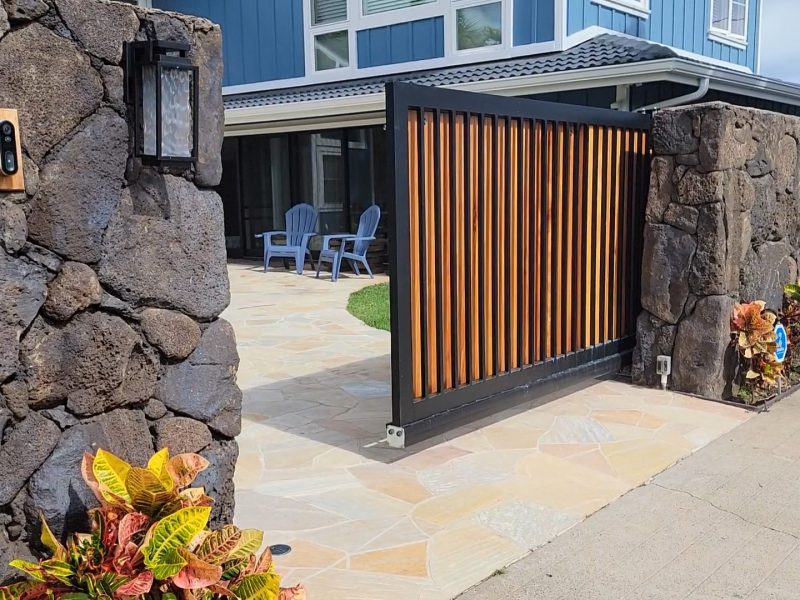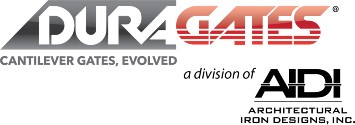
Sliding gates have become a popular choice for residential, commercial, and industrial properties alike — and for good reason. They offer a sleek, space-saving alternative to swing gates, operate smoothly in tight or sloped driveways, and provide a high level of security without sacrificing style.
As opposed to a swing gate, sliding gates follow either a bottom or top track and are stored to the side of the opening when the gate is open. This makes them more space-efficient for driveways or entrances
But a gate is only as good as the components behind it. The right track or cantilever hardware, rollers, guide systems, and safety features all work together to ensure dependable performance year after year. This is our ultimate guide to sliding gates, full of practical tips, product overviews, and maintenance recommendations.
Types of Sliding Gate Systems
There are three primary types of sliding gates: traditional on-ground track gates, overhead track systems, and cantilever trackless systems.
In an on-ground track model, the rollers, or wheels, of the gate run on a steel track that is bolted to a concrete surface. The track and rails provide a path for the wheels, ensuring the gate moves in a straight line. Due to the small frame, this model is easily installed and operated. The most important thing to watch out for is debris that may hinder the gate from opening or closing properly.
Conversely, an overhead track system functions similarly, but it is ideal when mounting hardware on the ground is not an option. With trackless gates, commonly known as cantilever gates, there are no ground tracks, and the system uses a counterbalance system to keep the gate moving smoothly. Cantilever gates reduce the risk of breaches or issues with the drive system because dirt and debris can’t hinder gate movement. It just becomes extremely important that the carriages are installed high enough to clear any inconsistencies in the terrain. Correct installation is also crucial to maintain balance and prevent sagging.
Why Should You Sell DuraGates Systems?
DuraGates represents the next generation of cantilever sliding gate technology, designed to help builders deliver gates that stand out for quality and performance.
One of the biggest advantages for builders is versatility. DuraGates hardware isn’t limited to just one type of project. It can be used for driveway gates, pedestrian fence gates, deck or patio barriers, and even sliding pocket walls or doors. No matter what material your customer prefers—iron, steel, aluminum, stainless steel, wood, chain link, or vinyl—DuraGates hardware is built to work seamlessly.
And because it’s engineered for all types of terrain, from dirt and gravel to cobblestone, pavers, slopes, or even areas near waterways, you can confidently recommend it for virtually any job site. By offering DuraGates to your customers, you’re not just selling hardware—you’re delivering long-term value through gates that are easier to install, safer to operate, and built to last. Here’s some more benefits of selling DuraGates sliding gates:
- High weight capacity (certain models can withstand up to 7,700lbs)
- Works with any gate material (stainless steel, aluminum, etc.)
- Low maintenance
- Minimal visible hardware
- Easy to install
- Durable for high traffic applications
Essential Gate Components
A sliding gate requires several structural components that provide support and stability during automation:
Structural Elements
The main structural element of a sliding gate is the frame. The gate frame is typically made from stainless steel, aluminum, or steel. The frame provides the main structure and must be strong enough to support all the components of the overall system during use, despite any external factors like wind and impact.
Movement Mechanisms
There are several moving parts that work together to ensure smooth operation of a sliding gate, specifically on-track systems:
- Tracks and rails — this component of the mechanism provides a path for the wheels to move in the right direction
- Rollers — the rollers are the wheels attached to the bottom of a ground-track gate and are typically made of rubber or steel
- Support Brackets — these brackets hold wheels in place and help to distribute weight evenly across the entire structure
- Cantilever rollers — essential components in a cantilever gate system, designed to support and guide a sliding gate as it moves open and closed
Support Hardware & Accessories
The most prominent component of gate support is the posts, which are the anchor points on either side of a gate opening. These are usually made from steel or reinforced concrete, depending on the design of the gate.
To help reinforce the frame and keep the track in place, a sliding gate requires braces and footings. This is especially important in locations with heavy winds or uneven ground. Here’s a look at how some sliding gate components come together to function smoothly and effectively:
Security & Safety Features
UL 325 Compliance: In the U.S., UL 325 is the governing safety standard for automatic gate operators. Compliance means the gate system includes the required safety devices, obstruction sensing, and fail-safe mechanisms to protect users. Choosing UL 325–compliant hardware and installation practices ensures both legal compliance and user safety.
Installation considerations
Before selecting a sliding gate system, the site should be carefully evaluated. Factors like slope, terrain type, available space, and soil conditions can all influence whether you choose a traditional track system or a cantilever (trackless) design. For example, uneven ground or frequent snow accumulation often makes cantilever gates the better choice.
Pro Tip: Mark out the full travel distance of the gate before purchasing—remember, sliding gates require space at least equal to the gate opening plus clearance.
Maintenance Tips
- Fun Fact: With DuraGates systems, you do NOT need to regularly lubricate rollers, hinges, tracks, and guides
- You should clean tracks and driveway paths to prevent dirt buildup
- Schedule regular inspections to check for corrosion, cracking, and worn parts so you can replace them proactively
- Ensure operator firmware and sensor calibration are up to date
Sliding Gates, Evolved
A sliding gate system is more than just a convenient entryway—it’s a long-term investment in security, curb appeal, and ease of access. Providing DuraGates products to your customers ensures high-quality components, easy installation, and long-term satisfaction.
Whether you’re installing a new system or upgrading an existing one, working with trusted suppliers can make all the difference in performance and safety. You’re not just selling gate parts; you are providing peace of mind and a sleek, seamless security system.
Ready to take the next step? Contact our team today to explore your sliding gate options, get expert advice, and find the perfect hardware for your project.

Recent Comments